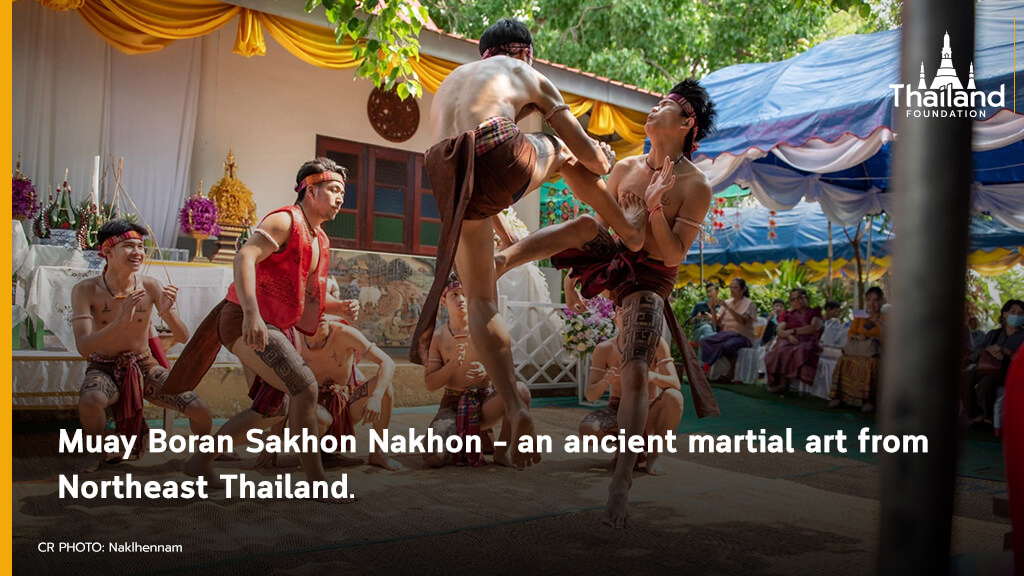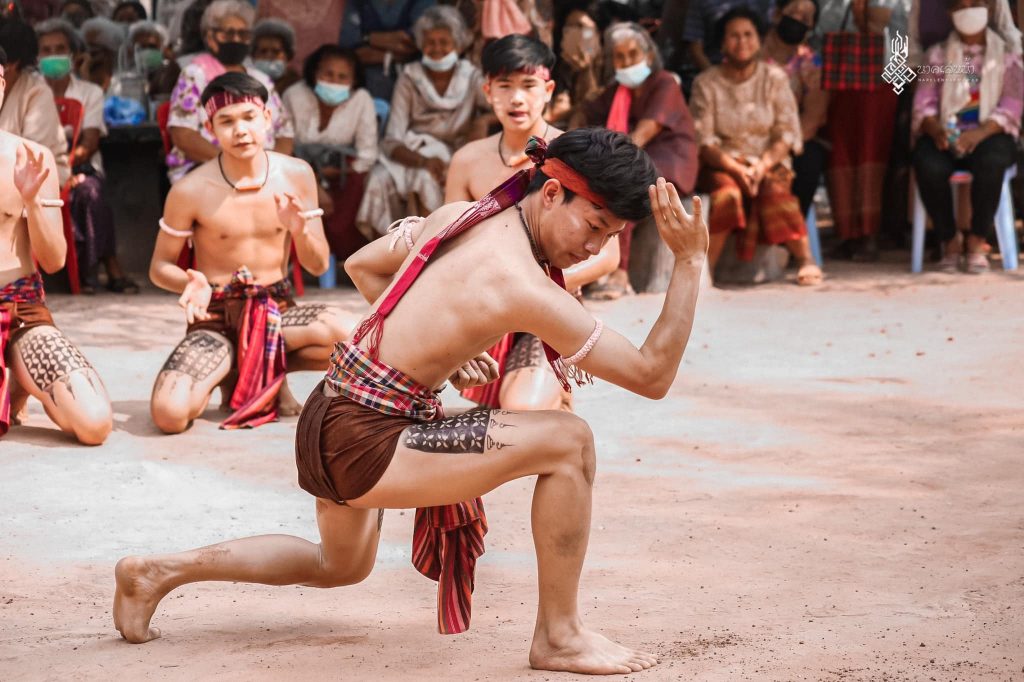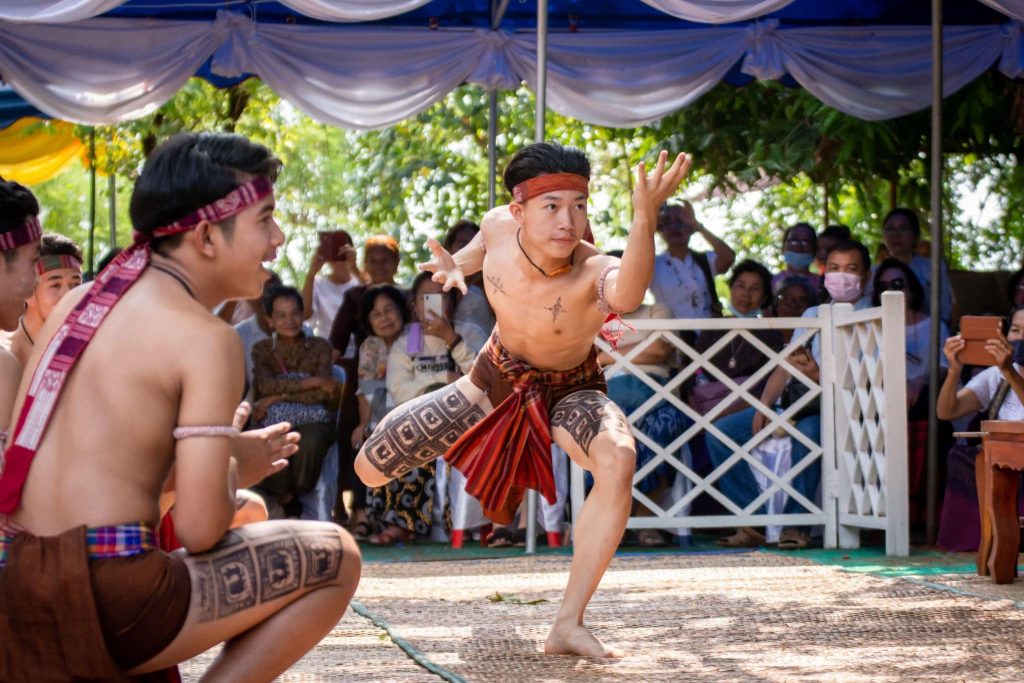High Kicks and Graceful Moves: Muay Boran Sakon Nakhon

The term “muay” (มวย) can be defined as an ancient form of martial arts that utilizes various body parts including the hands, elbows, feet, knees and, in some cases, even the head. There are many styles of muay that were widely practiced by warriors in ancient times. These ancient forms of fighting are known as Muay Boran (มวยโบราณ), or Ancient Kickboxing.
Back then, the Northeastern region of Thailand, known as Isaan, and particularly Sakon Nakhon Province, was home to various ethnic groups including the Yor, Phu Thai, Kalerng, and Yoy. Each possessed their own culture and traditions, especially the Yor, who made up the majority of Sakon Nakhon’s inhabitants. One of the traditions that has been handed down from generation to generation and has become a pride of the Sakon Nakhon people is Muay Boran Sakon Nakhon (มวยโบราณสกลนคร), the ancient fighting style of Sakon Nakhon.
History
No one knows exactly how long Muay Boran Sakon Nakhon has been around, though one fact is certain: this local martial art precedes modern forms of Muay Thai. It has been given many names, such as Muay Lao (มวยลาว), or Laotian Boxing, and Sua Lark Hang (เสือลากหาง), or Tail-Dragging Tiger. It was and is popularly taught at local temples to promote physical health and the ability to defend oneself. At the same time, there is also an element of beauty in the movements. Even magic spells are used to strengthen the fists, feet, knees, and elbows against the opponent.
The first person to begin keeping records of Muay Boran Sakon Nakhon was Khru Chamlong Nualmanee. A combat master in his own rigths, Khru Chamlong set out to systematically preserve his art form, going so far as to design many new fighting moves. Today, he is regarded as the curator of Muay Boran Sakon Nakhon which has grown into a recognised heritage of Sakon Nakhon.
The true Muay Boran Sakon Nakhon is usually expressed through dances during local religious events. At these auspicious events, each community will organize their own contingent for a colourful dancing parade. The highlight occurs during the Boon Pa Wes (Buddhist Sermon Festival). Representatives from 10 villages dance their way through the streets, beckoning the public to join them in offering reverence to the Choeng Choom Pagoda, one of the most sacred Buddhist monuments of Sakon Nakhon Province.
Among the colourful entourage in the parade are Muay Boran Sakon Nakhon troupes from each village, led by a band playing traditional musical instruments. The sight greatly excites the onlookers, especially when the fighters advance towards one another, each displaying their martial skills.
The Identity of Muay Boran Sakon Nakhon
Muay Boran Sakon Nakhon combines the grace of the local Isaan folk dance with ancient fighting skills. It is more a display of beautiful body choreography than close-range combat like other disciplines. This is why it is considered as a martial art “that has art in itself”, with no fixed rules or format.
The highlight of Muay Boran is the Wai Khru (ไหว้ครู) ritual dance, which fighters perform to demonstrate respect to their teachers. Movements during this sequence are borrowed from many animals such as tigers, elephants, horses, cows, and buffaloes, and adapted to match the rhythm from the pipes and drums. Some fighters even imitate movements of the monkeys and giants in the ancient Indian Ramayana epic during their performance.
The Dance
The Muay Boran Sakon Nakhon dance is divided into three categories: 1. group dance (in a parade); 2. Wai Khru dance; and 3. combat dance.
Group dances are held in open spaces, especially during processions. Fighters dance in pairs, imitating movements of animals.
The Wai Khru dance takes place before the combat. The referee performs his own dance to start the sequence and, as he exits the fighting grounds, the fighters, in red and blue outfits, will enter and perform their individual dances. There are a total 16 moves with names reflecting movements made by humans and animals including tigers, deer, chickens, horses, and elephants.
The combat dance is an exciting performance. Each participant will face off against another with a referee present. Fighting consists of using one’s palm to hit or slap an opponent. One fighter will attack the other and then retreat periodically to dance, before either re-launching the attack or assuming a stance of defense. Experienced fighters usually have lots of tricks up their sleeves both in defense and offense.

Muay Boran Sakon [cr. FB: naklhennam]
Muay Boran fighters who possess speed usually like to attack with their feet. When losing balance, quick fighters use their speed to evade blows and counterattack with their feet or elbows. Meanwhile, they must also watch out for a swipe kick coming from the opponent.
If a fighter falls to the ground, he is allowed to get up and continue the fight, since he is still capable of winning on skills. The winner is determined by the referee – if both fighters did equally well, the dance will be used to determine the winner. Today though, when a Muay Boran Sakon Nakhon fight ends, the referee will usually announce a draw and lifts the hands of both fighters to honor them.
In general, the performance comprises three males or more, with one acting as a referee and at least two as the fighters. Muay Boran Sakon Nakhon performers usually wear wavy loincloths, pulled up to reveal leg tattoos. The colors of the loincloth are red or blue, and the ends are left hanging down (for this reason the villagers often call the fighters “tail-dragging tigers”). They also have red or blue girdles depending on the loin cloth (the color must be the opposite). This girdle will help to tighten the loincloth so that the torso is bare, revealing more tattoos.
Another important dress code of Muay Boran Sakon Nakhon is an auspicious headdress (mongkhon) used during the Wai Khru dance. The headdress is blessed by the master, who places it on the fighter’s head before the dance and removes it before the fight. The fighter also wears upper arm bands (prachiad) – twined red cloth containing talismans – on both sides.
The dress code of the referee is similar to the fighters, the exception being a red talisman vest and necklace with a large number of amulets and relics.
Background music is mandatory in all Muay Boran Sakon Nakhon dance performances because it helps enliven the spirit of the fighters and spectators. The music is played on traditional Isaan folk instruments including the phin (mandolin), saw (bamboo fiddle), klong toom (two-faced drum), pong lang (xylophone), khong (gong), khaen (bamboo organ) and vode (bamboo flutes). The rhythm of the drums and percussions are what the fighters dance to. Phu Tai Loh Toob and Phu Tai Noi are the popular genres.
Values and Importance
The goal of Muay Boran Sakon Nakhon training is to strengthen the body, promote self-defense, and preserve the beautiful culture of the Sakon Nakhon people. It is a unique art that portrays the way of life and wisdom of the Isaan ancestors, which emphasizes comradery. As such, when the fight ends, no grudges are to be held. Fighters must conduct themselves as individuals with true sporting spirit.
 Muay Boran Sakon [cr. FB: naklhennam]
Muay Boran Sakon [cr. FB: naklhennam]
At present, Muay Boran Sakon Nakhon dances are only held in Sakon Nakhon province. But thanks to the hard work of Khru Chamlong Nualmanee, a large number of primary and secondary schools in the province now offer a Muay Boran curriculum in an effort to preserve the ancient art. Muay Boran performances are regularly performed in front of the public, and are broadcast on various television stations, helping the discipline gain more recognition.
Schools in Sakon Nakhon province recognise the importance of Muay Boran Sakon Nakhon, and have joined hands to continue the tradition, giving youngsters the opportunity to study and practise the discipline.
Further adaptations of the rhythm and choreography in aerobic dance form have also been introduced as exercise for the elderly and general public. This is yet another way of preserving the ancient art of Muay Boran Sakon Nakhon.
********************
Source
Pooksrisuk, Amnat. Muay Boran Sakon Nakhon [Sakon Nakhon’s Muay Boran]. Watthanatham Journal: Department of Cultural Promotion, vol. 53, no. 2, April-June 2014, p. 40-47. Available at http://magazine.culture.go.th/2014/2/Culturemag2014-2/assets/basic-html/index.html#41.


